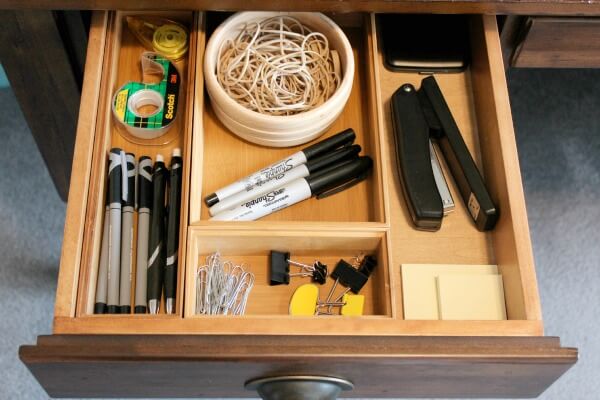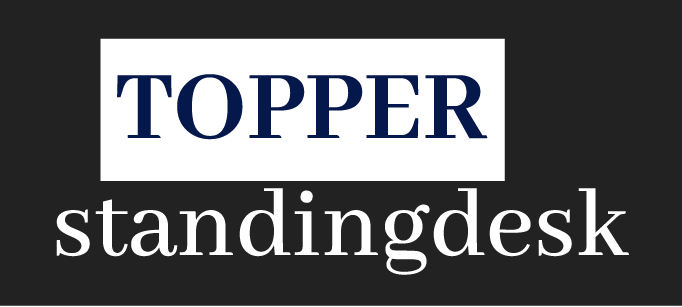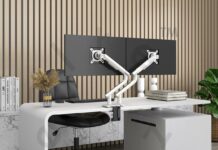It’s never a walk in the park to achieve an efficient workspace. In addition to setting up the right drawers, desks, lighting, computers, and more, you need to ensure everything is organized in an accessible and intuitive manner. More often than not, desk drawers are used to store most of the items and accessories in the office. Determining how to organize the items contained within them, therefore, becomes a challenging endeavor.

We recognize that a desk drawer is supposed to be a beautiful solution that enhances your productivity and makes work more enjoyable, as opposed to being a sea of chaos that yields frustration every time. That’s why we would like to share with you a few tips to help you with the efficient organization of your desk drawer.
Standingdesktopper's pick
- Study your space and decide what should stay top of the desk
- What needs to stay and what needs to go?
- Give first priority to the top drawer
- Dedicate a drawer for accommodating large items
- Fill the drawers in a step-wise fashion
- Keep everything organized
- Don’t worry about empty space
- Labeling
- Consider setting up a file-file folder drawer
- Organize the rest of the drawers by function
Study your space and decide what should stay top of the desk
It’s vital to review the tasks you’ll be undertaking in your office, so you can come up with an effective storage system that easily facilitates them. Will you be drawing? Writing? Scrap-booking? Computing? Etc.
Also, before delving into what should be contained in the desk drawers, it helps massively to first decide what ought to stay on the desktop. It wouldn’t be prudent to clear up all the mess in your workspace and just dump it in your desk drawers. Often times you’ll want to have a computer, a glass of water, teacup, printer, and more in front of you. Anything else that you really need by your side can make it there too.
You may, however, realize that you don’t need that much.
What needs to stay and what needs to go?
Then the next step is to analyze your drawer space. It’s common to find items in your drawers that you don’t need anymore. During this step, you’ll take out everything and figure out what is trash, what needs recycling, what to send to your supply closet, and what should go into your desk drawers. This process may take quite some time, so be patient. The good news is that when you are through, you’ll only be left with relevant items you use regularly.
Develop a hierarchy of importance
The most important drawers are usually the ones that are closest to you. Moreover, the closer the proximity of the drawer to your dominant hand, the more superior its importance. The items you use the most are usually the most important, though that doesn’t apply at all times.
Give first priority to the top drawer
It’s common to store items that are most relevant to our day-to-day tasks in the top drawers. A few of these items include pencils, pens, binder clips, index cards, and the stapler. In addition, we also keep our keys and wallets in the top drawer. It’s crucial to be particularly selective about the items that make it here. Deciding that everything is important is usually a recipe for disaster.
Dedicate a drawer for accommodating large items
You could also set aside another drawer for a few of the large items that could otherwise take up a lot of space on your desk, yet can easily be kept away. This drawer would be a good storage space for holding empty file folders and spare printer paper. Other items may include headsets, label makers, and more.
Fill the drawers in a step-wise fashion
One of the secrets to ensuring your drawer organization stays efficient and meaningful is adopting carefully-executed, step-wise criteria for each drawer. This process will be greatly influenced by your supplies as well as your personal needs. For instance, you may consider placing your business cards, pushpins, tape measure, and rulers in one drawer, computer accessories, and cables in another drawer, and a ream of printer paper in the next.
Keep everything organized
When you notice the items in your desk drawers begin to pile up, it’s beneficial to micro-organize your space, so all your items remain accessible and separate. Using desk drawer organizers offers a brilliant way of going about this.
Don’t worry about empty space
When you carry out the organization process with utmost care, you’ll realize you are left with some empty space. Try not to feel pressured into filling up empty drawers with more items. If you were careful when organizing your drawers, it means you categorized similar items together. Assigning your items extra space is not a sufficient justification for ending the continuity you initiated in your prior set up.
Labeling
If you realize you have multiple sets of drawers to deal with, one way to find your way easily would be to label them. A great choice for this task is the Dymo LetraTag Labelmaker.
Consider setting up a file-file folder drawer
You should consider yourself lucky if you find you have a drawer deep and wide enough to store your file folders. While you may already have a majority of your vital documents backed up in the cloud or on your hard drive, it’s wise to have your current hard-copy documents tucked inside your desk drawers, instead of on your desktop. Besides, this is a great way to boost convenience, plus it gets easier to swiftly retrieve these resources when you need to head over to a meeting, engage in an impromptu call, or get started on a project.
Nevertheless, to keep this system running smoothly, you’ll need to shred or recycle these files when they cease to be relevant. Be sure to make your file-folder drawer current and moving, rather than a fossil-bed for dumping all sorts of things.
Organize the rest of the drawers by function
For instance, you may have a finance drawer as well as a drawer for mail items. The mail drawer would house items like stamps, envelopes, return address labels, special-occasion cards, thank-you notes, and blank cards. Likewise, the finance drawer would consist of checkbooks, your passport, and other important documents. If some of the tasks you frequently engage in need special supplies, be sure to categorize them in a similar drawer, so you gain access to all items at once.
Related post: Jarvis vs Uplift: Who Has a Better Desk Drawer for your Office?




























